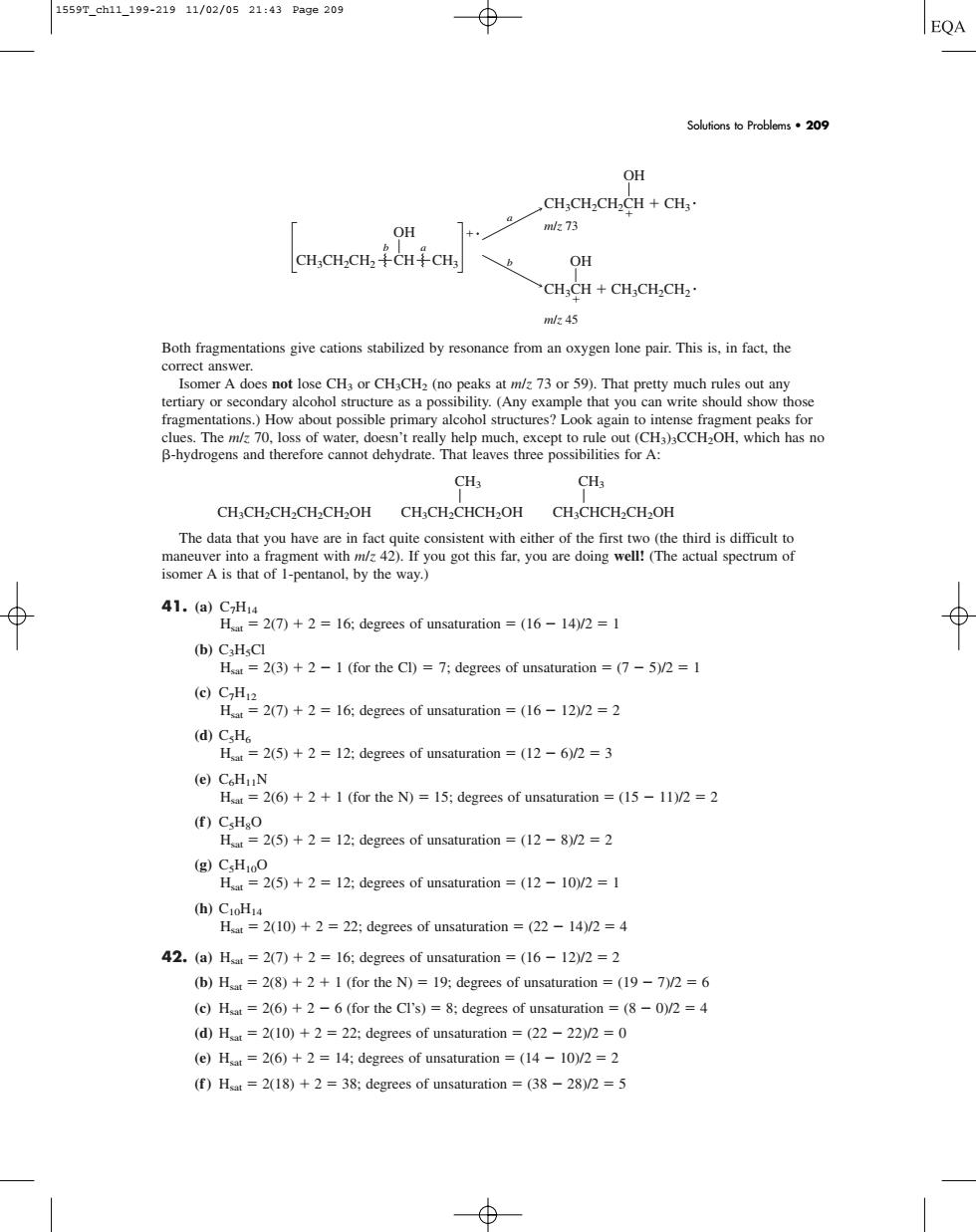正在加载图片...

1559T_ch11_199-21911/02/0521:43Pa9e209 ⊕ EQA Solutions to Problems.209 OH .CH,CH.CH.CH +CHs OH + mlz 73 CH,CH,CH,CHCH b OH CH.CH +CH.CH.CH2 mlz 45 Both fragmentations give cations stabilized by resonance from an oxygen lone pair.This is,in fact.the 59).That os. CCho经 CH3 CH CH-CH2CH-CH2OH CH:CHCHCHOH CHCHCH-CH OH The data that you have are in fact quite consistent with either of the first two (the third is difficult to m时 agment with m42).If you got this far,you are doing well!(The actual spectrum of 41.(a)CH =2(7)+2=16;degrees of unsaturation =(16-14)/2=1 (b)C3HsCl Ha =2(3)+2-1(for the Cl)=7;degrees of unsaturation =(7-5)/2= (e)C2H2 =2(7)+2=16;degrees of unsaturation =(16-12)/2=2 (d)C H Ha =2(5)+2=12;degrees of unsaturation=(12-6)2 =3 +1 (for the N)=15:desrces of unsaturation =(15-U2= (f)C:Ho H 2(5)+2=12:degrees of unsaturation =(12-8)2=2 2(5)+2=12:degrecs of unsaturation =(12-10)2 =1 (h)C (10)+=22;degrees of unsaturation =(22-14)2=4 42.(a)H=(7)+2=16;degrees of unsaturation=(16-12)/2= (b)Hat =2(8)++1 (for the N)=19;degrees of unsaturation =(19-7)/2=6 (c)H.=2(6)+2-6 (for the Cl's)=8:degrees of unsaturation =(8-012 =4 (d)H=2(10)+=22:degrees of unsaturation =(2-22)2=0 (e)H.ar =2(6)+2=14:degrees of unsaturation =(14 -10)2 =2 (f)Ha =2(18)+2=38;degrees of unsaturation =(38-28)2=5 Both fragmentations give cations stabilized by resonance from an oxygen lone pair. This is, in fact, the correct answer. Isomer A does not lose CH3 or CH3CH2 (no peaks at m/z 73 or 59). That pretty much rules out any tertiary or secondary alcohol structure as a possibility. (Any example that you can write should show those fragmentations.) How about possible primary alcohol structures? Look again to intense fragment peaks for clues. The m/z 70, loss of water, doesn’t really help much, except to rule out (CH3)3CCH2OH, which has no -hydrogens and therefore cannot dehydrate. That leaves three possibilities for A: CH3 CH3 A A CH3CH2CH2CH2CH2OH CH3CH2CHCH2OH CH3CHCH2CH2OH The data that you have are in fact quite consistent with either of the first two (the third is difficult to maneuver into a fragment with m/z 42). If you got this far, you are doing well! (The actual spectrum of isomer A is that of 1-pentanol, by the way.) 41. (a) C7H14 Hsat 2(7) 2 16; degrees of unsaturation (16 14)/2 1 (b) C3H5Cl Hsat 2(3) 2 1 (for the Cl) 7; degrees of unsaturation (7 5)/2 1 (c) C7H12 Hsat 2(7) 2 16; degrees of unsaturation (16 12)/2 2 (d) C5H6 Hsat 2(5) 2 12; degrees of unsaturation (12 6)/2 3 (e) C6H11N Hsat 2(6) 2 1 (for the N) 15; degrees of unsaturation (15 11)/2 2 (f ) C5H8O Hsat 2(5) 2 12; degrees of unsaturation (12 8)/2 2 (g) C5H10O Hsat 2(5) 2 12; degrees of unsaturation (12 10)/2 1 (h) C10H14 Hsat 2(10) 2 22; degrees of unsaturation (22 14)/2 4 42. (a) Hsat 2(7) 2 16; degrees of unsaturation (16 12)/2 2 (b) Hsat 2(8) 2 1 (for the N) 19; degrees of unsaturation (19 7)/2 6 (c) Hsat 2(6) 2 6 (for the Cl’s) 8; degrees of unsaturation (8 0)/2 4 (d) Hsat 2(10) 2 22; degrees of unsaturation (22 22)/2 0 (e) Hsat 2(6) 2 14; degrees of unsaturation (14 10)/2 2 (f ) Hsat 2(18) 2 38; degrees of unsaturation (38 28)/2 5 CH3CH2CH2 CH CH3 OH OH CH3CH2CH2CH m/z 73 CH3 OH CH3CH m/z 45 CH3CH2CH2 b a a b Solutions to Problems • 209 1559T_ch11_199-219 11/02/05 21:43 Page 209����������������